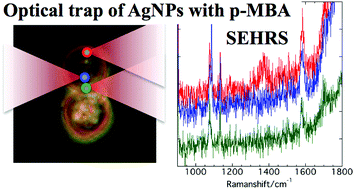Measurement of pH-dependent surface-enhanced hyper-Raman scattering at desired positions on yeast cells via optical trapping†
Abstract
Surface-enhanced hyper-Raman scattering (SEHRS) spectra were obtained at desired positions on yeast by focusing a continuous wave near-infrared laser beam while silver nanoparticles (AgNPs) were simultaneously optically trapped. However, the optically trapped colloidal AgNP suspension bubbled up at the focusing point, preventing spectral measurement. In the case of optically trapped AgNPs functionalized with 4-mercaptobenzoic acid (p-MBA), surface-enhanced hyper-Rayleigh scattering was considerably strong, indicating the suppression of the photothermal conversion to form the bubble. Interestingly, the SEHRS peaks that are attributed not only to p-MBA, but also to other species, were very occasionally observed. They may be partly assigned to the β1,3 glucan and protein amide II band. The SEHRS peak at 1366 cm−1 was barely visible in the measurements of conventional baker's yeast even in the suspension (pH 9) despite the effects of high pH on p-MBA. In contrast, the SEHRS peak in the measurements of yeast for biological applications was occasionally observed at 1366 cm−1. This suggests that acidity is correlated with fermentation efficiency. At different positions on single yeast cells, the intensity of the SEHRS peak at 1366 cm−1 varied. This result represents the pH distribution on yeast.



 Please wait while we load your content...
Please wait while we load your content...